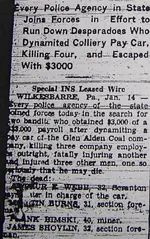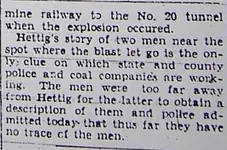PAYROLL CRIME: IT WAS A BLOODY PAYDAY
By JERRY KELLAR jkellar@leader.net
Sunday, March 18, 2001 Page: 1B
In the span of a few moments on Jan. 13, 1930, two ruthless bandits in search of a big score turned a Warrior Run colliery into a bloody tomb.
A little over a year later, John ``Tex'' Nafus and Sigismund ``Big Joe'' Szachewicz would pay the ultimate penalty for their heinous crimes. But not even death by electrocution seemed sufficient retribution for the families of four victims - families whose lives would never again be the same.
The pair's attempted robbery of the $35,000 payroll halfway between Truesdale colliery and No. 20 tunnel of Glen Alden Coal Co. might have succeeded but for the frightful carnage caused by the explosion of a huge charge of dynamite under an electric mine locomotive trailer used as an auxiliary pay car, and the courage of a one-armed guard.
Killed instantly were Arthur E. Webb, 32, paymaster, Scranton; Martin Burns, 31, assistant mine foreman, Sugar Notch; James Shovlin, 33, section foreman, Hanover Township; and Frank Brezinski, 36, miner, Plymouth - their bodies burned, broken and mangled .
All of the deceased left behind children. Sadly, Burns' wife gave birth to the couple's second son just days before the explosion.
According to the Wilkes-Barre Record, a police investigation revealed that Nafus, a Plymouth Township resident, and Szachewicz, a Jersey City, N.J., native who listed the Salvation Army in Wilkes-Barre as home, had placed a heavy charge of dynamite under the locomotive tracks, possibly sometime during the previous night.
The mine motor was allowed to pass over the heavy charge of explosives, but as soon as its cargo of men and money passed the spot, a radio battery was connected to the wire ends, setting off the fatal spark.
The bandits, meantime, barricaded themselves nearby in a clump of small pine trees, waiting for hell to erupt.
Interestingly, section foreman Stewart Hettig saw two strange men in the field near his railroad just minutes before the explosion. Hettig saw the same two men running across the field right after the blast.
The discharge, which made tinder of the heavy mine car, forced the lid from the strong iron box containing the payroll money and flattened into tinlike strips the iron compartments and trays.
As they moved in for the take, the thieves were startled to find 45-year-old John Sookie, a one-armed guard from Plymouth, protecting the scattered loot. Bruised, cut and in shock, Sookie was strong enough to verbally fend off Nafus and Szachewicz while waiting for police to arrive.
Harry Powell, the man in charge of operating the motor drawing the pay car, also made a miraculous escape.
He recounted the horrid experience to the newspaper.
``I was beginning to advance the speed of the motor after just having passed a wavy stretch of track,'' Powell said. ``Just when I had given it the last notch there was a terrific explosion behind me and I went into a daze. I couldn't imagine what had happened. I thought maybe the paycar had jumped the track. I looked back and saw a cloud of dust at the point where the motor broke away from the paycar. I went back to see what happened.''
What he found sickened Powell.
He saw the car in splinters and the bodies of his co-workers in pieces.
``Those who were not maimed were lying unconscious near the wrecked car,'' he said. ``I called for Rocky (Shovlin) and I thought I saw him coming up on the tracks from the left side.''
Told later that Shovlin had both his legs severed in the explosion, Powell realized the man he saw was probably one of the bandits.
Ironically, employees of the Warrior Run colliery often worried about the possibility of violence at the workplace.
``Everybody around the colliery used to talk about the place where the explosion was as an ideal place for a holdup, it's such a lonely spot and hidden from view by pine trees,'' a teary-eyed Powell said. ``Some of them used to say that it was strange some of these wild bandits never thought of holding up the pay car before.''
A graphic coroner's report quoted in the Wilkes-Barre Record detailed the victims' extensive and gruesome injuries.
The townspeople were outraged.
The manhunt was on.
Authorities checked out dozens of leads and tips over the following weeks and brought in several suspects for questioning.
On Feb. 21, police arrested Nafus and Szachewicz and charged them with four counts each of first-degree murder. A grand jury indicted them on March 10.
According to reports, they were ``electrocuted'' for their crimes sometime the following year.
Parts One & 2
http://thetimes-tribune.com/news/local-history-bandits-targeted-mine-s-pay-cars-1.1373707








